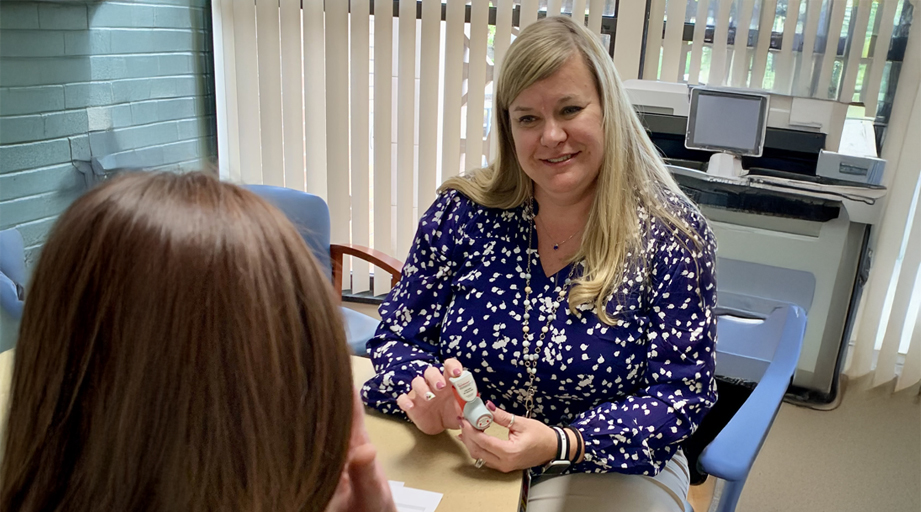
With help from ASHP's Practice Advancement Initiative (PAI) 2030 and other resources, Advocate Health is on its way to implementing a shared vision for pharmacy practice across a six-state integrated health network that includes 68 hospital locations and more than 1,000 ambulatory sites of care, serving nearly 6 million patients.

Kersten Weber Tatarelis, vice president of enterprise clinical pharmacy operations, said aligning pharmacy practice standards that promote patient-centered care is a top strategic priority for the department. A key element of this effort has been the adoption of guiding statements to advance three pillars of pharmacy practice: innovative models of clinical care delivery, transitions in care, and clinical decision support.
“With the size of our enterprise, there is a lot to tackle to continue to advance pharmacy practice in the spirit of PAI 2030,” Weber Tatarelis said. “We agreed to start with three fundamental pillars. Those are agreed-upon things that we believe are foundational to pharmacists’ practice at Advocate Health.”
The guiding statements were refined during an enterprise pharmacy-wide event, Advocate Health Enterprise Pharmacy Practice Model Summit, held January 28–30, 2024, in Charlotte, North Carolina. The theme of the event mirrored the philosophy of the department, One Pharmacy Strong.
Setting the stage
Weber Tatarelis explained that Advocate Health emerged from recent expansions to become the nation’s third-largest nonprofit health system — one with a large and varied pharmacy footprint across the continuum of care.
“The pharmacy leadership team recognized that much of the team had never met before, so it would be imperative for us to come together, philosophically and physically, as one department across our enterprise,” she said.
To lay the groundwork, the health system sent a pharmacy practice survey to the organization’s 3,700 pharmacists, including pharmacy leaders. About half of the pharmacists completed the survey.
Many of the survey questions were informed by the PAI 2030 statements and the PAI self-assessment tool. The questions also addressed local and regional pharmacy services, pharmacist practice expectations, perceptions of the future in pharmacy practice, insights on needs for future success of care delivery, and career satisfaction.

“The practice survey told us where we are the same and where are we different. It acknowledged variances in practice and opinions, which helped us understand as a leadership team what gaps we would be faced with during this initiative,” said Thomas Dilworth, assistant vice president of clinical pharmacy services for Advocate Health.
Katherine Mieure, assistant vice president of pharmacy services at Advocate Health’s Wake Forest Baptist market, said the survey also revealed “what our teammates and leaders believe in” as well as their ideas about how artificial intelligence and other technological advances could augment or affect pharmacy practice.
Equipped with the survey data, Weber Tatarelis, Dilworth, and Mieure planned the Charlotte summit. The 28 invited attendees — referred to as delegates because they voted as proxies for their colleagues back home — represented the full scope of pharmacy services in acute care, ambulatory care, and population health.
“We had frontline clinicians, we had directors of pharmacy from large tertiary care facilities, and pretty much everything in between,” Dilworth said.
Before traveling to Charlotte, the delegates had attended virtual meetings to get better acquainted and to review the pharmacy survey results. Dilworth said the virtual sessions also covered PAI 2030, the ASHP–ASHP Foundation Pharmacy Forecast report, several John W. Webb lectures, and other resources representing the collective wisdom of the profession.
A vision for pharmacy practice
In Charlotte, the delegates were asked to evaluate, react to, and edit draft statements related to each of the previously defined foundational pillars of pharmacy practice. A group of unbiased non-pharmacist facilitators helped keep the discussions about the statements on track.
“One of the big challenges early on with the group of delegates was not having them get too caught up in some of the minutia and the tactics,” Dilworth explained. “It was more allowing them to just say, ‘This is a standard that we’d like to execute on, let’s write it down and aspire to it, versus worrying, ‘Well, at my hospital, this might not be practical because of x, y, and z.’”
By the end of the meeting, the delegates had recommended 21 patient-centered guiding statements and prioritized them for future work.
Approved statement themes included: advancing innovative models of clinical services delivery; extending expertise across the enterprise; reducing care variation; developing efficiency and reducing redundant work; optimizing and standardizing transitions of care; and clinical decision support to facilitate practice model changes.
“We are really speaking about creating best practice standards of care for all of our patients everywhere,” Weber Tatarelis said. “Which allows us to move to transformative pharmacy practice — how we can do things differently than we do today.”
Staying engaged, looking ahead
Weber Tatarelis said the approved statements are being used to develop and implement action items for achieving long-term strategic goals.
“These action items are woven into core tactics of our strategic plan, executed on by leaders across the enterprise,” she said.
She added that the core concepts of PAI 2030 are reflected in statements about practice environments reflecting the full range of pharmacists’ education and training as well as “extending expertise to all patients, improving efficiency, and reducing variation in care.”
Success, Weber Tatarelis said, will be demonstrated by the implementation of a nimble, dynamic practice model that both supports the pharmacy workforce of the future and measures the outcomes of care delivery.
Mieure said the scope of the summit was limited to the pharmacy team’s acute care, ambulatory care, and population health services. She said the department will hold future events to address a strategic vision for retail pharmacy services and the role of pharmacy technicians.
She noted that the delegates were asked if they wanted to remain involved in the work they’d started and in future pharmacy practice initiatives.
“Everybody raised their hand to say that they wanted to continue to be involved, and they had some great ideas on how they could continue to be at the table for the next steps of our process,” Mieure said.
Weber Tatarelis said the overall process for defining pharmacy practice was meant to be empowering for the delegates.
“They were chosen to represent and impart pretty transformative change for Advocate Health and to set the tone for the future,” she said.







